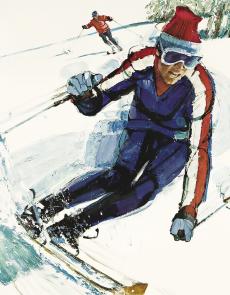SKIING HISTORY
Editor Seth Masia
Managing Editor Greg Ditrinco
Consulting Editor Cindy Hirschfeld
Art Director Edna Baker
Editorial Board
Seth Masia, Chairman
John Allen, Andy Bigford, John Caldwell, Jeremy Davis, Kirby Gilbert, Paul Hooge, Jeff Leich, Bob Soden, Ingrid Wicken
Founding Editors
Morten Lund, Glenn Parkinson
To preserve skiing history and to increase awareness of the sport’s heritage
ISHA Founder
Mason Beekley, 1927–2001
ISHA Board of Directors
Rick Moulton, Chairman
Seth Masia, President
Wini Jones, Vice President
Jeff Blumenfeld, Vice President
John McMurtry, Vice President
Bob Soden (Canada), Treasurer
Richard Allen, Skip Beitzel, Michael Calderone, Dick Cutler, Wendolyn Holland, Ken Hugessen (Canada), David Ingemie, Joe Jay Jalbert, Henri Rivers, Charles Sanders, Einar Sunde, Christof Thöny (Austria), Ivan Wagner (Switzerland)
Presidential Circle
Christin Cooper, Billy Kidd, Jean-Claude Killy, Bode Miller, Doug Pfeiffer, Penny Pitou, Nancy Greene Raine
Executive Director
Janet White
janet@skiinghistory.org
Membership Services
Laurie Glover
(802) 375-1105
laurie@skiinghistory.org
Corporate Sponsorships
Peter Kirkpatrick
(541) 944-3095
peterk10950@gmail.com
Bimonthly journal and official publication of the International Skiing History Association (ISHA)
Partners: U.S. Ski and Snowboard Hall of Fame | Canadian Ski Museum and Hall of Fame
Alf Engen Ski Museum | North American Snowsports Journalists Association | Swiss Academic Ski Club
Skiing History (USPS No. 16-201, ISSN: 23293659) is published bimonthly by the International Skiing History Association, P.O. Box 1064, Manchester Center, VT 05255.
Periodicals postage paid at Manchester Center, VT and at additional mailing offices. Postmaster: Send address changes to ISHA, P.O. Box 1064, Manchester Center, VT 05255
ISHA is a 501(c)(3) public charity. EIN: 06-1347398
Written permission from the editor is required to reproduce, in any manner, the contents of Skiing History, either in full or in part.
Hedda Berntsen, Norwegian Triple Threat
With medals in three different disciplines and a Ph.D., this multi-tasker is on her way to doing it all.
Within 13 years, Hedda Berntsen won a World Championship in telemark skiing, a World Championship bronze in slalom and an Olympic silver in skicross. That puts her in the versatility Hall of Fame along with Birger Ruud (won jumping gold, and the downhill half of Alpine combined, in the same Olympics) and Ester Ledecká (gold in super G and snowboarding). Now, at age 46, she owns a Ph.D. in sports psychology and still podiums in FIS races.
Photo above: Multi-discipline medalist Berntsen freeriding in Hemsedal, Norway. Tyler Conrad photo.
Berntsen lives with her husband, Tyler Conrad, near the ski resort of Hemsedal, Norway, in the winter and in coastal Tønsberg, in the summer. Conrad was a Middlebury ski teammate and baseball pitching ace who still holds the school’s strikeout record (177). Berntsen is an associate professor of performance psychology at the University of South-Eastern Norway and has hardly retired from competition. In March 2022, at age 45, she finished third and fourth in back-to-back FIS slaloms. Not Masters. She beat kids born in this century–26 years younger than herself. She raced recently on her 46th birthday, in April.
“I don’t like giving up, you know?” Berntsen says. “I’m still really having fun working on the slalom technique.”
Her current obsession is skateboarding. For the X Games? Nah. She already has two silver medals in skicross from the Winter X Games. She also owns national championship medals in moguls, downhill skiing, youth ski jumping and wakeboarding. She’s written four books and finished her Ph.D. in 2019. What hasn’t Berntsen done?
“Figure skating!” she says. Her bucket list also includes ice cross (roller derby on hockey skates down a luge-like chute); wing foiling (surfing on a hydrofoil stilt, pulled by a kite wing); freestyle dance (Flashdance and gymnastics, on crack); and tumbling (successive flips on a 25-meter sprung track).
More than that, Berntsen says, “I’ve always wanted to be a really great surfer. I have a lot of passions and interests, and I want to do it all. Obviously, you have to make choices and that’s not my strength. It’s the same in my academic career. I would like to learn design, psychology, motivation, teaching.”

year-old sister Ingrid.
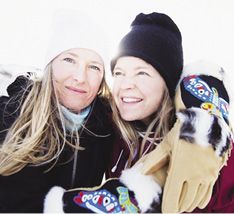
Olympics, 2022; Ingrid
competed in moguls, Hedda
silvered in skicross, at age 33.
Anki Grothe photo.
But how many people from a small fishing village on the Oslofjord actually pursue and excel internationally at most of their dreams?
Growing up in Filtvet with two siblings, Berntsen challenged herself all the time. Her father, Dag, had been a Nordic skier at Middlebury. Her mother, Marte, was an avid skier. When Berntsen was 5, her father experienced an aneurysm in his spinal cord and has been in a wheelchair ever since. “He’s fantastic, never gives up, very optimistic and positive,” Berntsen says. At 75, he still teaches math and science at the same middle school where Berntsen’s sister, Ingrid, a two-time Olympian in moguls, teaches physical education and science.
At age eight, Berntsen excelled at ski jumping. She beat almost all the boys well before women jumpers succeeded in their drive for international competition. “I was a little bit too early,” she says. At 13, she picked up Alpine skiing, started racing at 17 and dreamed of being a downhill racer.
During her two years at a Norwegian ski academy, Berntsen ran telemark gates at night for fun. Each summer, she trained in moguls with her sister. “It was a parallel development between all those disciplines,” she recalls, with “a lot of variation. Maybe that’s why I became so good so fast. To develop [expertise], it’s important to go out of your comfort zone all the time—and I was always wanting to improve and master [these sports].”
When Berntsen didn’t immediately make the national Alpine team, however, her father suggested she attend his alma mater. “I don’t know,” she remembers saying. “All I wanted to do was be a world-class skier. I didn’t think I would make it if I went to college, but I decided it was going to be possible. And it was possible, because I believed it.”
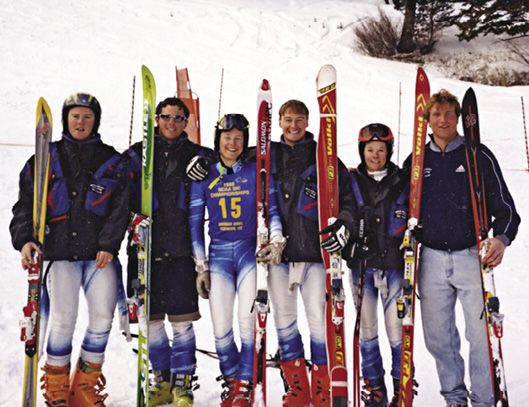
team at the 1998 NCAA Championships
at Bridger Bowl, Montana. Middlebury
Athletics photo.
She flew to Vermont, still so new to racing that, even now, Mark Smith, Middlebury’s Alpine director at the time, said he never would have recruited her. “I think her [FIS] point profile was in the 80s or 90s, and we were looking for athletes in the 30s,” he says. “But she was very intelligent about technique. She also worked at it tirelessly. I mean, she closed the lifts pretty much every day at Middlebury Snow Bowl. We would do training on Nordic skis and she would just about kill herself so she wouldn’t be last in any training situation. She was all attack, all the time. You’ve heard the term, ‘Attacking Vikings?’ Her picture should be in the book under that.”
Another Middlebury influence was her teammate Forest Carey, who raced for the Panthers after a stint on the U.S. Ski Team, then would go on to coach for the team for 14 years, minus a two-year gig as Bode Miller’s coach when Miller broke away from the national squad. Carey had a gift for explaining technique, even as an undergrad, so Berntsen picked his brain constantly.
“She was right on my ass, every training run,” Carey recalls. “Hedda comes down seven gates behind you and sprays you at the finish because she was so close and is so pumped, talking about the feelings, sensations, gets back on the lift and does it again. She had this crazy infectious energy. She was so different than anyone else I’d ever met. The determination. She was just gonna do it! Whatever it took. She had the attitude and the ability.
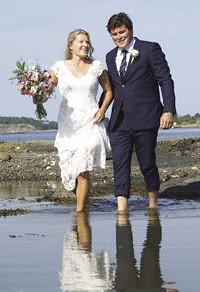
wedding day in Tjome, Norway.
Johan Wildhagen photo.
“She was the reason I made it through college skiing, frankly,” Carey admits. “She’d skateboard around campus, arcing turns, constant movement and activity.”
In 1997, Berntsen won gold at the Telemark World Championships in Meiringen, Switzerland, in a three-minute Classic (includes gates, skating and a jump. “I’ve never been more tired in my whole life, on the course or after,” she says). That year she set the Middlebury single-season scoring record in soccer and retired her cleats.
Carey was dismayed to see her leave soccer. “I’m like, ‘Hedda! What are you doin’?’” he remembers. “She says, ‘Forest! I like the games. But the [soccer] practice, you just run around. Then I can’t lift weights, then I can’t get strong enough to ski so fast.’ She’s the best soccer player the school had ever seen. People would just bounce the ball off her and she’d score. And she quit so she could ski faster! I was like, ‘You’re crazy!’”
After Middlebury, Berntsen went straight to the Alpine World Cup. In 2000–01, her first full season on tour, she earned seven top-10 finishes in slalom, including a trio of fifth places. In the same season—inconceivably—she captured bronze at the FIS Alpine World Championships at St. Anton, Austria, beating Janica Kostelic of Croatia, and sharing the podium with winner Anja Paerson of Sweden.
At the time, Berntsen wasn’t surprised. “Only when I look back at it, I can’t believe I was able to pull it off,” she says. “It shouldn’t be possible. But right there and then, I can never see any doubts. I am in complete belief that I’m going to become the world’s best. I was convinced.”
After the Middlebury years, which involved three months each year of racing, the transition to a world-class workout regimen was jarring. She suffered dangerous muscle deterioration. Bloodwork showed high creatine kinase, or CK, levels, which had the potential for kidney damage.
“The team didn’t let me individualize my program, so recovery took a really, really, really long time,” she says. By 2002, she was cleared for her Olympic debut in Salt Lake City (along with her sister in moguls), but skied out in the first run of slalom and ended her World Cup run in 2003.
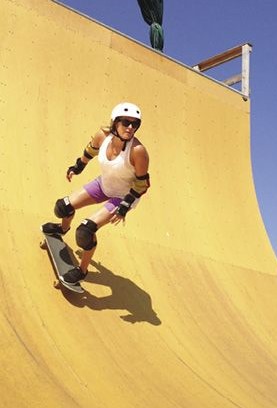
the vert ramp at the Tjome
skate park in Norway.
By 2010, however, Berntsen was back in full force, ready to compete in the Olympic premiere of skicross. In Vancouver, the 33-year-old Berntsen won every heat, beating even the eventual gold medalist in the semifinals. But she got a slow start in the final heat and claimed silver, behind Ashleigh McIvor of Canada.
Of all her athletic achievements, Berntsen thinks that Olympic silver was the most significant. “It was so unlikely and so late in my career,” she says. “I felt like I never fully reached my potential in Alpine skiing, so it was fantastic to be able to reach that level again.”
More good news followed, at Carey’s 2015 wedding in Mexico. “Hedda was coming in Hedda-style,” Carey says. “I was like, ‘Just get here and we’ll figure it out.’” When Carey had to run an errand, he told his sister, ‘Hedda’s coming in a half hour. Tell Tyler to look after her.’” The college ski teammates reconnected and made an indelible mark on the dance floor. “To this day, everyone still laughs because they were dancing together all night, but it was like a plyo workout, like calisthenics, which fits them both to a tee,” Carey says. “Tyler’s also a phenomenal athlete.”
“In Tyler, I met my match,” Berntsen says. “Relationships were always hard, because I usually beat the boys in stuff, but he beats me at absolutely everything.” Four years later, they married.
Now that Berntsen has a Ph.D. in sports psychology, she has been thinking about her meteoric and multi-faceted ski racing career and reading all her old training logs. She wants to write a scientific article about skill development. “There are a lot of theories on how [sports] learning happens,” she says. “It’s very complex, and sometimes you don’t get the complexity in the theories. For me, it’s been very cognitive. I spent a lot of time analyzing and connecting the feeling of a good turn to what I’d see on video and in coaches’ feedback. Of course, it’s just my own experience, but I have it documented quite well. I wrote journals every single year that I was a ski racer, since 1994: what I wanted to work on, what worked, how many runs I did, how I understood the turns. I cut out pictures of Alpine skiers and glued them in, I made ski development models that I created myself,” she explains.
Those journals could be doubly useful now, because Berntsen still has athletic goals. “I really want to improve in Alpine skiing!” she says. “It would be fun to go to Nationals and be top 15 in slalom. But my job is super demanding, and I can’t always ski as much as all those kids. But that’s the big dream.”
If she did it, no one would flinch.
“People ask me, because of my coaching background, ‘Who’s the best athlete I’ve been around?’” Carey says. “I give half the people the easy answer: Bode, one of the best athletes that ever put on skis and what excitement he brought to people. A lot of it was because he wouldn’t take no for an answer. But I tell the other half: Hedda. Look what she’s freaking accomplished, with her results and her enthusiasm for playing sports. She dives into s*** with such passion and so much energy. She’s one of my favorite people in the world.” 
Aimee Berg is a sportswriter base in New York. She profiled Marco Tonazzi in the May-June issue of Skiing History.
.jpg)
Table of Contents
WORLD CHAMPIONSHIP ($3,000+)
BerkshireEast/Catamount Mountain Resorts
Gorsuch
Warren and Laurie Miller
Sport Obermeyer
Polartec
CHAMPIONSHIP ($2,000)
Fairbank Group: Bromley, Cranmore, Jiminy Peak
Hickory & Tweed
Rossignol
Snowsports Merchandising Corporation
WORLD CUP ($1,000)
Aspen Skiing Company
Atomic USA
Bogner of America
Boyne Resorts
Dale of Norway
Darn Tough Vermont
Dynastar/Lange/Look
Gordini USA Inc/Kombi LTD
Head Wintersports
Intuition Sports
Mammoth Mountain
Marker/Völkl USA
National Ski Areas Association
North Carolina Ski Areas Association
Outdoor Retailer
Ski Area Management
Ski Country Sports
Sports Specialists Ltd
Sugar Mountain Resort
Sun Valley Resort
Vintage Ski World
World Cup Supply
GOLD MEDAL ($700)
Larson's Ski & Sports
Race Place/Beast Tuning Tools
The Ski Company (Rochester NY)
Thule
SILVER MEDAL ($500)
Alta Ski Area
Boden Architecture PLLC
Dalbello Sports
Deer Valley
EcoSign Mountain Resort Planners
Elan
Fera International
Holiday Valley Resort
Hotronic USA/Wintersteiger
Kulkea
Leki
Masterfit Enterprises
McWhorter Driscoll LLC
Metropolitan New York Ski Council
Mt. Bachelor
New Jersey Ski & Snowboard Council
Nils
Russell Mace Vacation Homes
SchoellerTextil
Scott Sports
Seirus Innovations
SeniorsSkiing.com
Ski Utah
Snowbird Ski & Summer Resort
Steamboat Ski & Resort Corp
Sundance Mountain Resort
Swiss Academic Ski Club
Tecnica Group USA
Timberline Lodge and Ski Area
Trapp Family Lodge
Wendolyn Holland
Western Winter Sports Reps Association
World Pro Ski Tour


